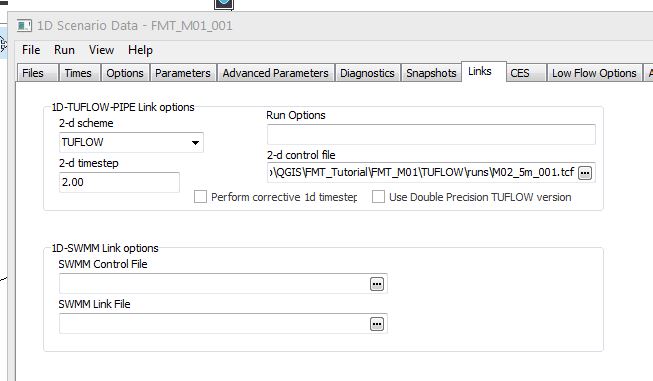Flood Modeller Tutorial Module01: Difference between revisions
Tuflowduncan (talk | contribs) |
|||
| (17 intermediate revisions by 5 users not shown) | |||
| Line 4: | Line 4: | ||
1D-2D linked models are able to utilise the individual benefits of 1D and 2D solution schemes. In this example, the 1D Flood Modeller scheme is used to represent the watercourses where the flow is essentially uni-directional. A 2D scheme is suited to the representation of floodplains where more complex flow patterns may occur. <br> |
1D-2D linked models are able to utilise the individual benefits of 1D and 2D solution schemes. In this example, the 1D Flood Modeller scheme is used to represent the watercourses where the flow is essentially uni-directional. A 2D scheme is suited to the representation of floodplains where more complex flow patterns may occur. <br> |
||
<br> |
<br> |
||
As [[ |
As [[Tutorial_Module01_Archive#Reviewing_Model_Performance | discussed in Module 1 of the TUFLOW Tutorial Model]], the main watercourse channel is not very well represented using the 5m 2D cell size. In parts, the watercourse is only 5-10m wide and the 5m cell size could be considered too coarse to accurately represent the watercourse topography.<br> |
||
[[file:Poor_2d_rep.png|400px]]<br> |
[[file:Poor_2d_rep.png|400px]]<br> |
||
Using a cell size that is coarse relative to the width of the watercourse channel may reduce the accuracy of the conveyance in the channel. There are two options for improving the representation of the creek channel:<br> |
Using a cell size that is coarse relative to the width of the watercourse channel may reduce the accuracy of the conveyance in the channel. There are two options for improving the representation of the creek channel:<br> |
||
* decrease the width of the 2D cells; and/or |
* decrease the width of the 2D cells; and/or |
||
* model the channel as a 1D network, dynamically linked to the 2D domain (the floodplain). |
* model the channel as a 1D network, dynamically linked to the 2D domain (the floodplain). |
||
In the [[ |
In the [[Tutorial_Module01_Archive#Advanced_-_Model_Resolution_.28Optional.29 | optional section of Module 1 of the TUFLOW Tutorial Model]], we looked at reducing the cell size to get a better representation of the channel. In this module we will adopt the second approach of modelling the creek as 1D elements using Flood Modeller.<br> |
||
TUFLOW may be dynamically linked to 1D networks using the hydrodynamic solutions of ESTRY (TUFLOW 1D), Flood Modeller |
TUFLOW may be dynamically linked to 1D networks using the hydrodynamic solutions of ESTRY (TUFLOW 1D), Flood Modeller, XP-SWMM and 12D Solutions’ Dynamic Drainage.<br> |
||
Setting up a 1D/2D model where the 1D channel cuts through the 2D domain is probably the most time-consuming type of a model to setup. However, the reduction in simulation time can be beneficial and make this a good approach. For this module, the complete Flood Modeller 1D model has been provided, to allow for progressing through the module in a relatively short period of time.<br> |
Setting up a 1D/2D model where the 1D channel cuts through the 2D domain is probably the most time-consuming type of a model to setup. However, the reduction in simulation time can be beneficial and make this a good approach. For this module, the complete Flood Modeller 1D model has been provided, to allow for progressing through the module in a relatively short period of time.<br> |
||
=Existing Model Data= |
=Existing Model Data= |
||
This tutorial builds upon the 2D TUFLOW domain that was constructed as part of [[Tutorial |
This tutorial builds upon the 2D TUFLOW domain that was constructed as part of [[Tutorial Module01_Archive|Module 1]] and [[Tutorial Module02_Archive|Module 2]] of the TUFLOW Tutorial Model.<br> |
||
The model developed in these tutorial modules already contains some culverts modelled as 1D elements. The culverts are modelled in ESTRY, TUFLOW's internal 1D engine. One of these culverts will be kept in ESTRY and the other will be added to the Flood Modeller model.<br> |
The model developed in these tutorial modules already contains some culverts modelled as 1D elements. The culverts are modelled in ESTRY, TUFLOW's internal 1D engine. One of these culverts will be kept in ESTRY and the other will be added to the Flood Modeller model.<br> |
||
The 2D boundary conditions (upstream inflows and downstream stage-discharge boundary) will be removed from the model. These will instead be represented in Flood Modeller as it is a more typical schematisation for a 1D/2D linked model.<br> |
The 2D boundary conditions (upstream inflows and downstream stage-discharge boundary) will be removed from the model. These will instead be represented in Flood Modeller as it is a more typical schematisation for a 1D/2D linked model.<br> |
||
| Line 25: | Line 25: | ||
*1D/2D boundary links to connect the 1D ESTRY culverts to the 2D TUFLOW domain. |
*1D/2D boundary links to connect the 1D ESTRY culverts to the 2D TUFLOW domain. |
||
For further information on these elements, please refer to [[Tutorial |
For further information on these elements, please refer to [[Tutorial Module01_Archive|Module 1]] and [[Tutorial Module02_Archive|Module 2]] of the TUFLOW Tutorial Model. |
||
==Flood Modeller== |
==Flood Modeller== |
||
| Line 34: | Line 34: | ||
*<b>IEF</b>: A blank folder in which to store Flood Modeller Event Files used to simulate the model. |
*<b>IEF</b>: A blank folder in which to store Flood Modeller Event Files used to simulate the model. |
||
*<b>RES</b>: A blank folder in which to write the Flood Modeller result files. |
*<b>RES</b>: A blank folder in which to write the Flood Modeller result files. |
||
For further information on each file type, please refer to the [ |
For further information on each file type, please refer to the [https://help.floodmodeller.com/docs Flood Modeller User Manual].<br> |
||
For this tutorial, the floodplain of the study area will be modelled entirely in TUFLOW. |
For this tutorial, the floodplain of the study area will be modelled entirely in TUFLOW. |
||
The cross-sections in the Flood Modeller 1D model have been trimmed to the top of bank to ensure there is no double-counting of storage within the floodplain. |
The cross-sections in the Flood Modeller 1D model have been trimmed to the top of bank to ensure there is no double-counting of storage within the floodplain. |
||
| Line 80: | Line 80: | ||
'''Mapinfo'''<br> |
'''Mapinfo'''<br> |
||
Add an extra command line after <font color="blue"><tt> Read GIS Code </tt></font><font color="red"><tt>==</tt></font>..\model\mi\2d_code_FMT_M01_001_R.MIF </li> |
Add an extra command line after <font color="blue"><tt> Read GIS Code </tt></font><font color="red"><tt>==</tt></font>..\model\mi\2d_code_FMT_M01_001_R.MIF </li> |
||
:<font color="blue"><tt>Read GIS Code BC </tt></font> <font color="red"><tt>== </tt></font> mi\ |
:<font color="blue"><tt>Read GIS Code BC </tt></font> <font color="red"><tt>== </tt></font> mi\2d_bc_FMT_M01_HX_001_R.MIF<font color="green"><tt> ! Deactivates the cells where the watercourse has been modelled in 1D </tt></font> |
||
| ⚫ | |||
| ⚫ | |||
'''Other GIS'''<br> |
'''Other GIS'''<br> |
||
Add an extra command line after <font color="blue"><tt> Read GIS Code </tt></font><font color="red"><tt>==</tt></font>..\model\gis\2d_code_FMT_M01_001_R.shp |
Add an extra command line after <font color="blue"><tt> Read GIS Code </tt></font><font color="red"><tt>==</tt></font>..\model\gis\2d_code_FMT_M01_001_R.shp |
||
:<font color="blue"><tt>Read GIS Code BC </tt></font> <font color="red"><tt>== </tt></font> gis\2d_bc_FMT_M01_HX_001_R.shp <font color="green"><tt> ! Deactivates the cells where the watercourse has been modelled in 1D </tt></font> |
:<font color="blue"><tt>Read GIS Code BC </tt></font> <font color="red"><tt>== </tt></font> gis\2d_bc_FMT_M01_HX_001_R.shp <font color="green"><tt> ! Deactivates the cells where the watercourse has been modelled in 1D </tt></font> |
||
Note that the order of the commands is important. The layer '''2d_code_FMT_M01_001_R.shp''' first activates cells within the modelled area then the layer 2d_bc_FMT_M01_HX_001_R.shp''' deactivates selected cells along the watercourse. |
Note that the order of the commands is important. The layer '''2d_code_FMT_M01_001_R.shp''' first activates cells within the modelled area then the layer '''2d_bc_FMT_M01_HX_001_R.shp''' deactivates selected cells along the watercourse. |
||
<li> Topography amendments should be added in a new section at the bottom of the TGC. These are: </li> |
<li> Topography amendments should be added in a new section at the bottom of the TGC. These are: </li> |
||
| Line 113: | Line 112: | ||
'''Mapinfo''' |
'''Mapinfo''' |
||
:Put an exclamation mark before the line reading. This tells TUFLOW to treat this command line as a comment:<br> |
:Put an exclamation mark before the line reading. This tells TUFLOW to treat this command line as a comment:<br> |
||
:<font color="blue"><tt>Read GIS BC</tt></font> <font color="red"><tt>== </tt></font> mi\ |
:<font color="blue"><tt>Read GIS BC</tt></font> <font color="red"><tt>== </tt></font> mi\2d_bc_M01_002_L.MIF |
||
'''Other GIS''' |
'''Other GIS''' |
||
:Put an exclamation mark before the line reading:<br> |
:Put an exclamation mark before the line reading:<br> |
||
| Line 120: | Line 119: | ||
<li> Update the 1D/2D boundary links at the ESTRY culverts with the new layer:</li> |
<li> Update the 1D/2D boundary links at the ESTRY culverts with the new layer:</li> |
||
'''Mapinfo''' |
'''Mapinfo''' |
||
:<font color="blue"><tt>Read GIS BC</tt></font> <font color="red"><tt>== </tt></font> mi\ |
:<font color="blue"><tt>Read GIS BC</tt></font> <font color="red"><tt>== </tt></font> mi\2d_bc_M04_culverts_001_L.MIF <font color="green"><tt>! This command reads in SX boundaries linking the 1D ESTRY culverts to the 2D domain</tt></font> |
||
'''Other GIS''' |
'''Other GIS''' |
||
:<font color="blue"><tt>Read GIS BC</tt></font> <font color="red"><tt>== </tt></font> gis\2d_bc_M04_culverts_001_L.shp <font color="green"><tt>! This command reads in SX boundaries linking the 1D ESTRY culverts to the 2D domain</tt></font> |
:<font color="blue"><tt>Read GIS BC</tt></font> <font color="red"><tt>== </tt></font> gis\2d_bc_M04_culverts_001_L.shp <font color="green"><tt>! This command reads in SX boundaries linking the 1D ESTRY culverts to the 2D domain</tt></font> |
||
| Line 126: | Line 125: | ||
<li> Add reference to the 1D/2D boundary links that connect Flood Modeller to the 2D floodplain:</li> |
<li> Add reference to the 1D/2D boundary links that connect Flood Modeller to the 2D floodplain:</li> |
||
'''Mapinfo''' |
'''Mapinfo''' |
||
:<font color="blue"><tt>Read GIS BC </tt></font> <font color="red"><tt>== </tt></font> mi\ |
:<font color="blue"><tt>Read GIS BC </tt></font> <font color="red"><tt>== </tt></font> mi\2d_bc_FMT_M01_HX_001_p.MIF | mi\2d_bc_FMT_M01_HX_001_L.MIF<font color="green"><tt>! This command reads in HX boundaries linking the 1D Flood Modeller watercourse to the 2D domain</tt></font> |
||
'''Other GIS''' |
'''Other GIS''' |
||
:<font color="blue"><tt>Read GIS BC </tt></font> <font color="red"><tt>== </tt></font> gis\2d_bc_FMT_M01_HX_001_p.shp | gis\2d_bc_FMT_M01_HX_001_L.shp <font color="green"><tt>! This command reads in HX boundaries linking the 1D Flood Modeller watercourse to the 2D domain</tt></font> |
:<font color="blue"><tt>Read GIS BC </tt></font> <font color="red"><tt>== </tt></font> gis\2d_bc_FMT_M01_HX_001_p.shp | gis\2d_bc_FMT_M01_HX_001_L.shp <font color="green"><tt>! This command reads in HX boundaries linking the 1D Flood Modeller watercourse to the 2D domain</tt></font> |
||
| Line 153: | Line 152: | ||
<li> We need to read in the GIS layers of the Flood Modeller Nodes. Place the below command line anywhere in the .tcf. It is good practice to create a section within the .tcf to reference all 1D commands: <br> </li> |
<li> We need to read in the GIS layers of the Flood Modeller Nodes. Place the below command line anywhere in the .tcf. It is good practice to create a section within the .tcf to reference all 1D commands: <br> </li> |
||
'''Mapinfo'''<br> |
'''Mapinfo'''<br> |
||
:<font color="blue"><tt>Read GIS X1D Nodes</tt></font> <font color="red"><tt>== </tt></font>..\model\mi\ |
:<font color="blue"><tt>Read GIS X1D Nodes</tt></font> <font color="red"><tt>== </tt></font>..\model\mi\1d_x1d_FMT_M01_nodes_001_P.MIF <font color="green"><tt>! GIS layer referencing node IDs from Flood Modeller </tt></font> |
||
'''Other GIS'''<br> |
'''Other GIS'''<br> |
||
:<font color="blue"><tt>Read GIS X1D Nodes</tt></font> <font color="red"><tt>== </tt></font>..\model\gis\1d_x1d_FMT_M01_nodes_001_P.shp <font color="green"><tt>! GIS layer referencing node IDs from Flood Modeller </tt></font> |
:<font color="blue"><tt>Read GIS X1D Nodes</tt></font> <font color="red"><tt>== </tt></font>..\model\gis\1d_x1d_FMT_M01_nodes_001_P.shp <font color="green"><tt>! GIS layer referencing node IDs from Flood Modeller </tt></font> |
||
| Line 159: | Line 158: | ||
<li> Add commands to read in the GIS layers referencing Water Level Lines drawn along the Flood Modeller component of the model: <br> </li> |
<li> Add commands to read in the GIS layers referencing Water Level Lines drawn along the Flood Modeller component of the model: <br> </li> |
||
'''Mapinfo'''<br> |
'''Mapinfo'''<br> |
||
:<font color="blue"><tt>Read GIS X1D Network</tt></font> <font color="red"><tt>== </tt></font>..\model\mi\ |
:<font color="blue"><tt>Read GIS X1D Network</tt></font> <font color="red"><tt>== </tt></font>..\model\mi\1d_x1d_FMT_M01_nwk_001_L.MIF <font color="green"><tt>! GIS layer representing channels to allow for the digitisation of Water Level Lines (optional)</tt></font> |
||
:<font color="blue"><tt>Read GIS X1D WLL</tt></font> <font color="red"><tt>== </tt></font> ..\model\mi\ |
:<font color="blue"><tt>Read GIS X1D WLL</tt></font> <font color="red"><tt>== </tt></font> ..\model\mi\1d_x1d_WLL_FMT_M01_001_L.MIF <font color="green"><tt>! GIS layer containing WLLs for visualising 1D results in 2D (optional)</tt></font> |
||
'''Other GIS'''<br> |
'''Other GIS'''<br> |
||
:<font color="blue"><tt>Read GIS X1D Network</tt></font> <font color="red"><tt>== </tt></font>..\model\gis\1d_x1d_FMT_M01_nwk_001_L.shp <font color="green"><tt>! GIS layer representing channels to allow for the digitisation of Water Level Lines (optional)</tt></font> |
:<font color="blue"><tt>Read GIS X1D Network</tt></font> <font color="red"><tt>== </tt></font>..\model\gis\1d_x1d_FMT_M01_nwk_001_L.shp <font color="green"><tt>! GIS layer representing channels to allow for the digitisation of Water Level Lines (optional)</tt></font> |
||
| Line 216: | Line 215: | ||
<br> |
<br> |
||
In the <b>Complete_Model\FMT_M01\Flood_Modeller\IEF</b> folder a batch file has been provided. To use the batch file in this tutorial:<br> |
In the <b>Complete_Model\FMT_M01\Flood_Modeller\IEF</b> folder a batch file has been provided. To use the batch file in this tutorial:<br> |
||
*Ensure that you [ |
*Ensure that you [https://wiki.tuflow.com/Running_linked_Flood_Modeller_-_TUFLOW_Models set up the installation folders]. |
||
*Move the batch file to the <b>FMT_Tutorial\FMT_M01\Flood_Modeller\IEF</b> folder |
*Move the batch file to the <b>FMT_Tutorial\FMT_M01\Flood_Modeller\IEF</b> folder |
||
*Open the batch file in a text editor. On the 'set FloodModeller=' line, change the path from the one provided to the full path to the ISISf32.exe file that you set up with the installation folders. |
*Open the batch file in a text editor. On the 'set FloodModeller=' line, change the path from the one provided to the full path to the ISISf32.exe file that you set up with the installation folders. |
||
| Line 222: | Line 221: | ||
*Double click the batch file in your file explorer to run the file |
*Double click the batch file in your file explorer to run the file |
||
<br> |
<br> |
||
When the simulation is running, the Flood Modeller status window will open. Flood Modeller will then open a |
When the simulation is running, the Flood Modeller status window will open. Flood Modeller will then open a tab with the TUFLOW output. <br> |
||
[[file: |
[[file:FMP_Sim_Screen.png|500px]]<br> |
||
The simulation will take a few minutes depending on the hardware setup.<br> |
The simulation will take a few minutes depending on the hardware setup.<br> |
||
<br> |
<br> |
||
=Review the Results= |
=Review the Results= |
||
Modelled results can be processed, reviewed and visualised in many different packages.<br> |
Modelled results can be processed, reviewed and visualised in many different packages.<br> |
||
For a complete introduction to the different options, [ |
For a complete introduction to the different options, [[Tutorial_Module01_Archive#Viewing_Results | refer to Tutorial Module 1]]. <br> |
||
<br> |
<br> |
||
| Line 261: | Line 261: | ||
</ol> |
</ol> |
||
<br> |
<br> |
||
If you experience an issue that is not detailed above please send an email to support@tuflow.com<br> |
If you experience an issue that is not detailed above please send an email to [mailto:support@tuflow.com support@tuflow.com]<br> |
||
=Conclusion= |
|||
We introduced the user to the linking of a TUFLOW 2D domain to a 1D Flood Modeller model.<br> |
|||
For further training opportunities see <u>[https://tuflow.com/training/training-course-catalogue/ TUFLOW Training Catalogue]</u> and/or contact <u>[mailto:training@tuflow.com training@tuflow.com]</u>. <br> |
|||
<br> |
|||
{{Tips Navigation |
|||
|uplink=[[Flood_Modeller_Tutorial_Model| Back to Flood Modeller Tutorial Model]] |
|||
}} |
|||
Latest revision as of 17:01, 23 October 2025
Introduction
In this module we will link an existing 2D TUFLOW domain to an existing Flood Modeller 1D model. The 2D TUFLOW domain will represent the floodplain in the study area, and the 1D Flood Modeller model will represent the watercourse and all online structures.
1D-2D linked models are able to utilise the individual benefits of 1D and 2D solution schemes. In this example, the 1D Flood Modeller scheme is used to represent the watercourses where the flow is essentially uni-directional. A 2D scheme is suited to the representation of floodplains where more complex flow patterns may occur.
As discussed in Module 1 of the TUFLOW Tutorial Model, the main watercourse channel is not very well represented using the 5m 2D cell size. In parts, the watercourse is only 5-10m wide and the 5m cell size could be considered too coarse to accurately represent the watercourse topography.
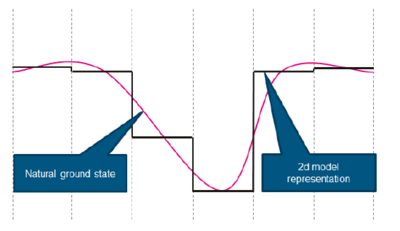
Using a cell size that is coarse relative to the width of the watercourse channel may reduce the accuracy of the conveyance in the channel. There are two options for improving the representation of the creek channel:
- decrease the width of the 2D cells; and/or
- model the channel as a 1D network, dynamically linked to the 2D domain (the floodplain).
In the optional section of Module 1 of the TUFLOW Tutorial Model, we looked at reducing the cell size to get a better representation of the channel. In this module we will adopt the second approach of modelling the creek as 1D elements using Flood Modeller.
TUFLOW may be dynamically linked to 1D networks using the hydrodynamic solutions of ESTRY (TUFLOW 1D), Flood Modeller, XP-SWMM and 12D Solutions’ Dynamic Drainage.
Setting up a 1D/2D model where the 1D channel cuts through the 2D domain is probably the most time-consuming type of a model to setup. However, the reduction in simulation time can be beneficial and make this a good approach. For this module, the complete Flood Modeller 1D model has been provided, to allow for progressing through the module in a relatively short period of time.
Existing Model Data
This tutorial builds upon the 2D TUFLOW domain that was constructed as part of Module 1 and Module 2 of the TUFLOW Tutorial Model.
The model developed in these tutorial modules already contains some culverts modelled as 1D elements. The culverts are modelled in ESTRY, TUFLOW's internal 1D engine. One of these culverts will be kept in ESTRY and the other will be added to the Flood Modeller model.
The 2D boundary conditions (upstream inflows and downstream stage-discharge boundary) will be removed from the model. These will instead be represented in Flood Modeller as it is a more typical schematisation for a 1D/2D linked model.
The existing TUFLOW model consists of:
- Definition of Active/In-Active Areas
- Definition of Land Use
- 1D ESTRY culverts
- 1D/2D boundary links to connect the 1D ESTRY culverts to the 2D TUFLOW domain.
For further information on these elements, please refer to Module 1 and Module 2 of the TUFLOW Tutorial Model.
Flood Modeller
A complete Flood Modeller 1D model of the watercourse has been provided for the purposes of this tutorial.
The model data has been arranged in the following folder structure:
- DAT: Contains the Flood Modeller 1D network file.
- IED: Contains event data of the model.
- IEF: A blank folder in which to store Flood Modeller Event Files used to simulate the model.
- RES: A blank folder in which to write the Flood Modeller result files.
For further information on each file type, please refer to the Flood Modeller User Manual.
For this tutorial, the floodplain of the study area will be modelled entirely in TUFLOW.
The cross-sections in the Flood Modeller 1D model have been trimmed to the top of bank to ensure there is no double-counting of storage within the floodplain.
Upstream and downstream boundary data is contained separately within the IED files. These will be referenced and linked to the Flood Modeller 1D model via the IEF simulation file.
GIS and Model Inputs
The steps necessary to modify each of the GIS inputs are demonstrated in MapInfo, ArcGIS and QGIS. At each stage please select your GIS package to view relevant instructions.
Define the External 1D Networks
This part of the module creates the GIS layers that specify the location of the Flood Modeller nodes that are to be connected to the 2D domain. Follow the instructions below for your preferred GIS package.
Define the 1D/2D Boundary Links
This part of the module creates the 1D/2D boundaries to link the Flood Modeller 1D component to the TUFLOW 2D domain. Follow the instructions below for your preferred GIS package.
Define Bank Elevations
This part of the module defines the bank elevations of the watercourse which are the elevations of the 1D/2D boundary links created in the previous section. Follow the instructions below for your preferred GIS package.
Deactivate 2D cells
This part of the module describes the steps to deactivate the 2D cells where the 1D model is replacing the 2D solution. Follow the instructions below for your preferred GIS package.
Modify Simulation Control Files
Now that we have made all of the necessary changes to the GIS layers, we need to update the TUFLOW control files and Flood Modeller Simulation Files to create a linked model.
TUFLOW Control Files
TUFLOW Geometry Control File
We will first update the TUFLOW Geometry Control (TGC) file. The following changes have been changes made to the geometry:
- We have deactivated the cells along the watercourse which are represented in the 1D Flood Modeller component of the model
- We have enforced bank elevations along the watercourse.
- In the FMT_Tutorial\FMT_M01\TUFLOW\model folder, save a copy of M01_5m_002.tgc as FMT_M01_001.tgc.
- Open FMT_M01_001.tgc
Mapinfo
Add an extra command line after Read GIS Code ==..\model\mi\2d_code_FMT_M01_001_R.MIF - Read GIS Code BC == mi\2d_bc_FMT_M01_HX_001_R.MIF ! Deactivates the cells where the watercourse has been modelled in 1D
- Read GIS Code BC == gis\2d_bc_FMT_M01_HX_001_R.shp ! Deactivates the cells where the watercourse has been modelled in 1D
- Topography amendments should be added in a new section at the bottom of the TGC. These are: Mapinfo
- Read GIS Z HX Line MAX == mi\2d_bc_FMT_M01_HX_001_L.MIF | mi\2d_bc_FMT_M01_HX_001_P.MIF ! Defines the bank crest levels (1D/2D boundary cell elevations). The 'MAX' option prevents any zpt elevations from being lowered
- Read GIS Z HX Line MAX == gis\2d_bc_FMT_M01_HX_001_L.shp | gis\2d_bc_FMT_M01_HX_001_P.shp ! Defines the bank crest levels (1D/2D boundary cell elevations). The 'MAX' option prevents any zpt elevations from being lowered
- Save the file. The geometry control file is now ready to be used.
Other GIS
Add an extra command line after Read GIS Code ==..\model\gis\2d_code_FMT_M01_001_R.shp
TUFLOW Boundary Condition Control File
We will now update the TUFLOW Boundary Condition control file (tbc) to reference the model boundary files created in previous steps.
- Open M02_5m_001.tbc and save a copy as FMT_M01_001.tbc.
- Remove the boundary linking to the TUFLOW inflows by:
Mapinfo- Put an exclamation mark before the line reading. This tells TUFLOW to treat this command line as a comment:
- Read GIS BC == mi\2d_bc_M01_002_L.MIF
- Put an exclamation mark before the line reading:
- Read GIS BC == gis\2d_bc_M01_002_L.SHP
- Put an exclamation mark before the line reading. This tells TUFLOW to treat this command line as a comment:
- Update the 1D/2D boundary links at the ESTRY culverts with the new layer: Mapinfo
- Read GIS BC == mi\2d_bc_M04_culverts_001_L.MIF ! This command reads in SX boundaries linking the 1D ESTRY culverts to the 2D domain
- Read GIS BC == gis\2d_bc_M04_culverts_001_L.shp ! This command reads in SX boundaries linking the 1D ESTRY culverts to the 2D domain
- Add reference to the 1D/2D boundary links that connect Flood Modeller to the 2D floodplain: Mapinfo
- Read GIS BC == mi\2d_bc_FMT_M01_HX_001_p.MIF | mi\2d_bc_FMT_M01_HX_001_L.MIF! This command reads in HX boundaries linking the 1D Flood Modeller watercourse to the 2D domain
- Read GIS BC == gis\2d_bc_FMT_M01_HX_001_p.shp | gis\2d_bc_FMT_M01_HX_001_L.shp ! This command reads in HX boundaries linking the 1D Flood Modeller watercourse to the 2D domain
- Save the file. The boundary control file is now ready to be used.
TUFLOW Control File
Finally, we need to edit the TUFLOW control file (.tcf). We will:
- In the \FMT_Tutorial\FMT_M01\TUFLOW\runs folder, save a copy of the TUFLOW file created as a part of module 2 (M02_5m_001.tcf) as FMT_M01_001.tcf.
- In a linked Flood Modeller - TUFLOW model, the Start Time, End Time and 2D Timestep are read from the Flood Modeller .ief file. It is best practice to therefore remove these parameters from the tcf. And an exclamation mark in front of each of the below commands.
! SIMULATION TIME CONTROL COMMANDS- Timestep == 1.5 ! Specifies a 2D computational timestep of 1.5 seconds
- Start time == 0 ! Specifies a simulation start time of 0 hours
- End Time == 3 ! Specifies a simulation end time of 3 hours
- We need to read in the GIS layers of the Flood Modeller Nodes. Place the below command line anywhere in the .tcf. It is good practice to create a section within the .tcf to reference all 1D commands:
Mapinfo - Read GIS X1D Nodes == ..\model\mi\1d_x1d_FMT_M01_nodes_001_P.MIF ! GIS layer referencing node IDs from Flood Modeller
- Read GIS X1D Nodes == ..\model\gis\1d_x1d_FMT_M01_nodes_001_P.shp ! GIS layer referencing node IDs from Flood Modeller
- Add commands to read in the GIS layers referencing Water Level Lines drawn along the Flood Modeller component of the model:
Mapinfo - Read GIS X1D Network == ..\model\mi\1d_x1d_FMT_M01_nwk_001_L.MIF ! GIS layer representing channels to allow for the digitisation of Water Level Lines (optional)
- Read GIS X1D WLL == ..\model\mi\1d_x1d_WLL_FMT_M01_001_L.MIF ! GIS layer containing WLLs for visualising 1D results in 2D (optional)
- Read GIS X1D Network == ..\model\gis\1d_x1d_FMT_M01_nwk_001_L.shp ! GIS layer representing channels to allow for the digitisation of Water Level Lines (optional)
- Read GIS X1D WLL == ..\model\gis\1d_x1d_WLL_FMT_M01_001_L.shp ! GIS layer containing WLLs for visualising 1D results in 2D (optional)
- Add commands to read in the an Esty Control File which contains references to some of the culverts present on the floodplain:
- ESTRY Control File == ..\model\FMT_M01_001.ecf !Reference the ESTRY Control File
- Finally, update the links to the Geometry control file, the Boundary Condition control file and the bc_dbase file:
- Geometry Control File == ..\model\FMT_M01_001.tgc
- BC Control File == ..\model\FMT_M01_001.tbc
- BC Database == ..\bc_dbase\bc_dbase_FMT_M01.csv
Flood Modeller Simulation Files
In the FMT_M01\Flood_Modeller folder, we have provided a complete Flood Modeller model. It is located in the DAT, IED and IEF folders.
The DAT and IED files are complete and will not require any modification to link to TUFLOW.
However, we will alter the IEF to create the link. The IEF alterations can be done either in a text editor of your choice or using the Flood Modeller Interface.
The instructions below have been written for the Flood Modeller Interface version 4.2.
IEF File
- Open Flood Modeller. Select 'Load 1D Network'. Navigate to \FMT_Tutorial\FMT_M01\Flood_Modeller\DAT and load the FMT_M01_001.dat.
- Right click 'Event Data' and select 'Add Item'. Navigate to \FMT_Tutorial\FMT_M01\Flood_Modeller\IED and load the FMT_Inflows.IED.
- On the 'Simulation' tab, click New 1D Simulation. Save the file when prompted in the \FMT_Tutorial\FMT_M01\Flood_Modeller\IEF folder asFMT_M01_001.ief
- On the 'Files' Tab of the simulation window, set the following parameters:
- Event Title: FMT_M01_001
- 1D Data File: The full path to the \FMT_Tutorial\FMT_M01\Flood_Modeller\DAT\FMT_M01_001.dat
- Use Initial Conditions from: Network File (.dat)
- Results File: the full path to \FMT_Tutorial\FMT_M01\Flood_Modeller\RES\FMT_M01_001
- To the right of the Event Data box, click Add and select the FMT_Inflows.IED file in the \FMT_Tutorial\FMT_M01\Flood_Modeller\IED folder.
- On the 'Times' tab, we will replace the simulation time parameters that were removed from TUFLOW. Enter the following parameters:
- Run Type: Unsteady (Fixed Timestep)
- Start Time (hrs): 0
- Finish Time (hrs): 3
- Timestep (s):1
- Save Interval (s): 300
- Add the 'Links' tab by clicking View> Tabs > Links. On the 'Links' tab, enter the following parameters:
- 2-d Scheme: TUFLOW
- 2-d Timestep: 2
- 2-d control file: full path to the FMT_M01_001.tcf from the \FMT_Tutorial\FMT_M01\TUFLOW\runs folder
- Add the 'Additional Output' tab by clicking View> Tabs > Additional Output. On the 'Additional Output' tab, select the check box for '2D Flow...'. This will add extra output to check the Flood Modeller and TUFLOW link. We will review this additional output in the following section.
- Save the Scenario Data.
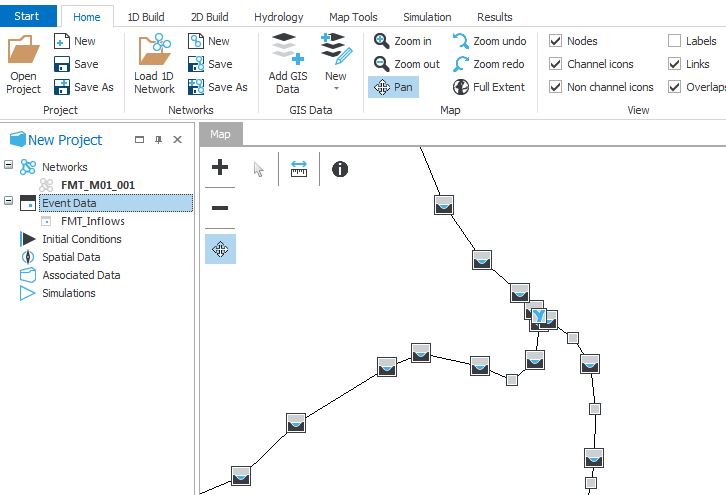
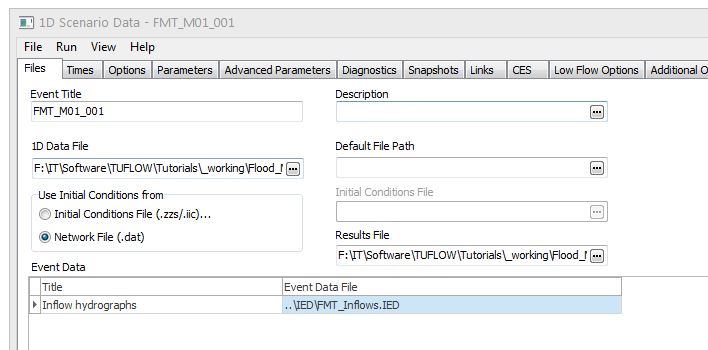
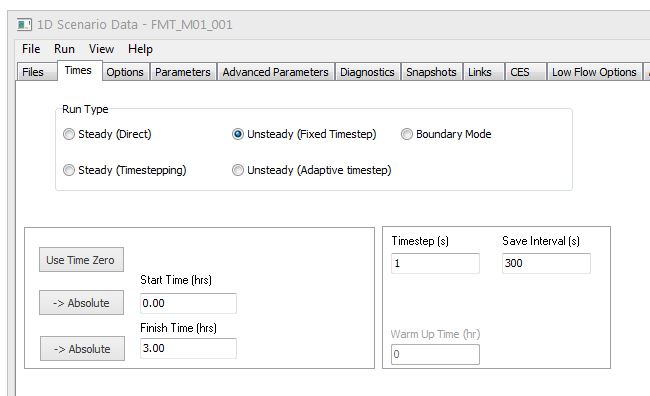
Run the Simulation
There are a number of different methods in which to start a Flood Modeller – TUFLOW model. Please refer to the following page for a detailed discussion on each of these methods.
Use your preferred method to start the model FMT_M01_001.ief or follow the guidance below. If the simulation fails to start, please refer to the troubleshooting guidance on this page.
In the Complete_Model\FMT_M01\Flood_Modeller\IEF folder a batch file has been provided. To use the batch file in this tutorial:
- Ensure that you set up the installation folders.
- Move the batch file to the FMT_Tutorial\FMT_M01\Flood_Modeller\IEF folder
- Open the batch file in a text editor. On the 'set FloodModeller=' line, change the path from the one provided to the full path to the ISISf32.exe file that you set up with the installation folders.
- Save and close the file
- Double click the batch file in your file explorer to run the file
When the simulation is running, the Flood Modeller status window will open. Flood Modeller will then open a tab with the TUFLOW output.
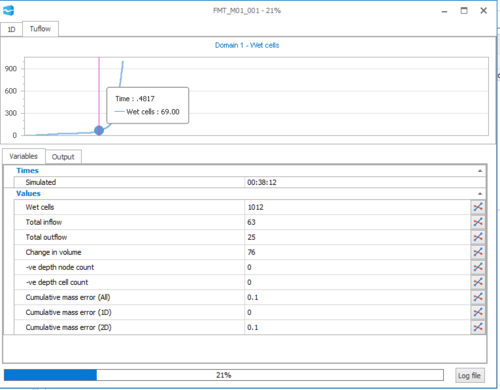
The simulation will take a few minutes depending on the hardware setup.
Review the Results
Modelled results can be processed, reviewed and visualised in many different packages.
For a complete introduction to the different options, refer to Tutorial Module 1.
TUFLOW HPC
To run the linked TUFLOW-Flood Modeller Pro model using HPC we simply need to add a single line to the Tuflow Control File. The HPC solver will only speed up the 2D calculations within the linked 1D-2D model, it will not speed up the 1D calculations that take place in the Flood Modeller Engine. The relatively small nature of this specific model means that use of HPC on multiple CPU cores may not lead to significant improvements to model run times. However, should the machine have an NVIDIA GPU card present then it is possible to run the HPC solver on the GPU to significantly improve model runs times. The larger the 2D domain, the more significant the improvements to model run times through the use of the HPC solver. To utilise the HPC solver:-
- Save the TUFLOW runfile ( FMT_M01_001.tcf) as FMT_M01_002.tcf.
- Add the following command to the TCF file:
- Solution Scheme == HPC ! Use HPC solver to run the simulation
- If you have a CUDA enabled NVIDIA GPU device, you can also add the following command to run the HPC solver using GPU hardware:
- Hardware == GPU ! Run HPC solver on GPU
- Save the TCF file and run the model.Troubleshooting for GPU Simulation
Troubleshooting for GPU Simulation
If you receive the following error when trying to run the TUFLOW HPC model using GPU hardware:
TUFLOW GPU: Interrogating CUDA enabled GPUs … TUFLOW GPU: Error: Non-CUDA Success Code returned
or
ERROR 2785 - No GPU devices found, enabled or compatible.
Please try the following steps:
- Check if your GPU card is an NVIDIA GPU card. Currently, TUFLOW does not run on AMD type GPU.
- Check if your NVIDIA GPU card is CUDA enabled and whether the latest drivers are installed. Please see GPU Setup.
If you experience an issue that is not detailed above please send an email to support@tuflow.com
Conclusion
We introduced the user to the linking of a TUFLOW 2D domain to a 1D Flood Modeller model.
For further training opportunities see TUFLOW Training Catalogue and/or contact training@tuflow.com.
| Up |
|---|
